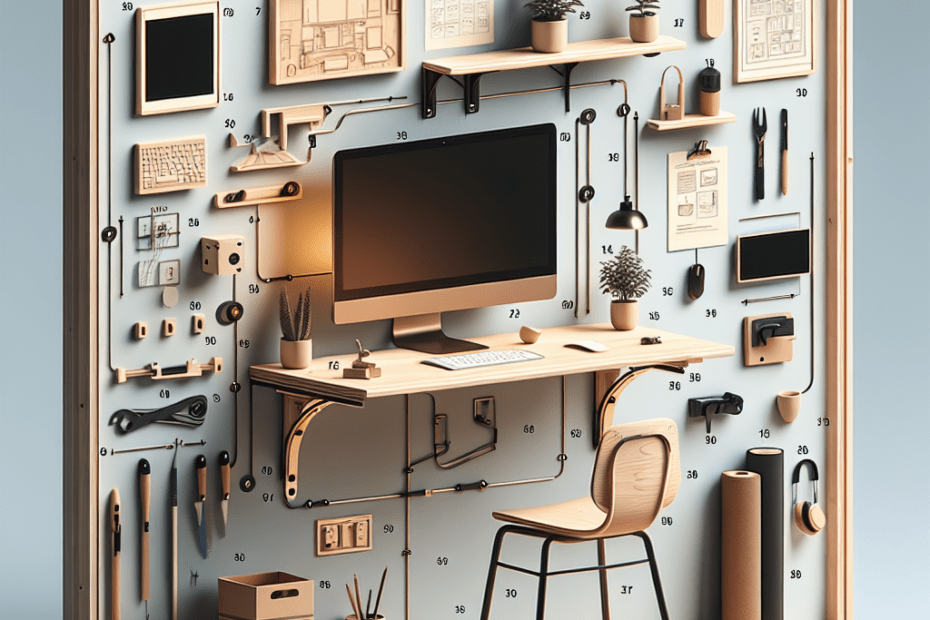They often find themselves struggling with space management in their homes, especially when it comes to integrating a workspace. Enter the DIY floating desk solution. This creative and practical furniture piece offers a workspace without compromising the precious floor area. This article will guide them through the process of creating their own DIY floating desk, perfect for small spaces.
As the shift towards remote work continues, with 22% of the American workforce expected to be working entirely from home by 2025 (source: Upwork), the demand for efficient home office setups is increasing. A floating desk is a wall-mounted workspace, providing room for work essentials, without the bulkiness of traditional desks.
The advantages of a DIY floating desk include:
- Space-saving: Perfect for small apartments or rooms with limited space.
- Customizable: They can tailor the design to their specific needs and aesthetic preferences.
- Cost-effective: Building their own desk can be more affordable than purchasing a ready-made model.
- Clutter-free: Having a designated spot for work items helps maintain organization.
To construct a DIY floating desk, they will need the following materials:
| Materials | Quantity |
|---|---|
| Wood or plywood sheet | 1 piece (custom dimensions) |
| Wall brackets | 2-3 (depending on desk size) |
| Wood screws | As needed |
| Drill | 1 |
| Screwdriver | 1 |
| Stud finder | 1 |
| Level | 1 |
| Paint or finish | Optional |
Step 1: Measure and Plan
They should assess their available wall space to determine the desk’s dimensions. It’s important to account for the height and width that best suits their needs and ergonomic comfort.
Step 2: Cut the Desk Surface
Using a wood or plywood sheet, they should cut it into the desired size. If needed, professional cutting services can be utilized at local hardware stores.
Step 3: Attach Wall Brackets
Once they identify the wall studs using a stud finder, they should attach the wall brackets at the desired height, ensuring they are level and evenly spaced. Wall brackets provide necessary support for the desk and are critical for maintaining a stable platform.
Step 4: Secure the Desk Surface
After preparing the wall brackets, they will align the wood piece on top and secure it with wood screws. A checking of the level ensures that the surface is even and ready for use.
Step 5: Finishing Touches
For a personal touch, they can paint or stain the desk surface. Adding decorations or organizational accessories like cable management systems can further enhance the desk’s utility.
According to Home Office Design Trends 2023 by Houzz, 19% of homeowners made workspaces more engaging with unique furniture designs like floating desks. The increase in remote work has prompted individuals to innovate within their home settings, optimizing small spaces for dual functionality and aesthetic appeal.
Key Takeaways
- DIY floating desks offer a space-efficient and cost-effective solution for small workspaces.
- Proper planning and execution are essential to ensure a sturdy and functional desk.
- Customization options allow the desk to fit individual style preferences and needs.
FAQs
- What is a floating desk?
A floating desk is a wall-mounted desk with no legs, creating the appearance of it ‘floating’ in place. It helps save floor space and is ideal for compact areas.
- How much weight can a floating desk support?
This depends on the materials and the proper installation of brackets. A study installation with robust materials can support several kilograms.
- Can they add storage to a floating desk?
Yes, incorporating shelves or drawers below the desk can provide additional storage solutions.
- Do they need professional help to build a floating desk?
Not necessarily. With the right tools and materials, anyone can follow the instructions to construct a DIY floating desk. However, professional assistance can ensure precision and stability if they are uncertain about the process.
- What are some tips for decorating a floating desk?
They can personalize their desk with plants, artwork, and desk organizers. Ensuring proper lighting and a comfortable chair will also enhance their workspace.
